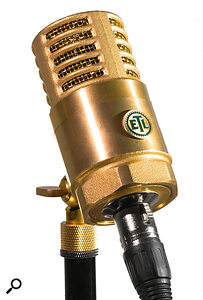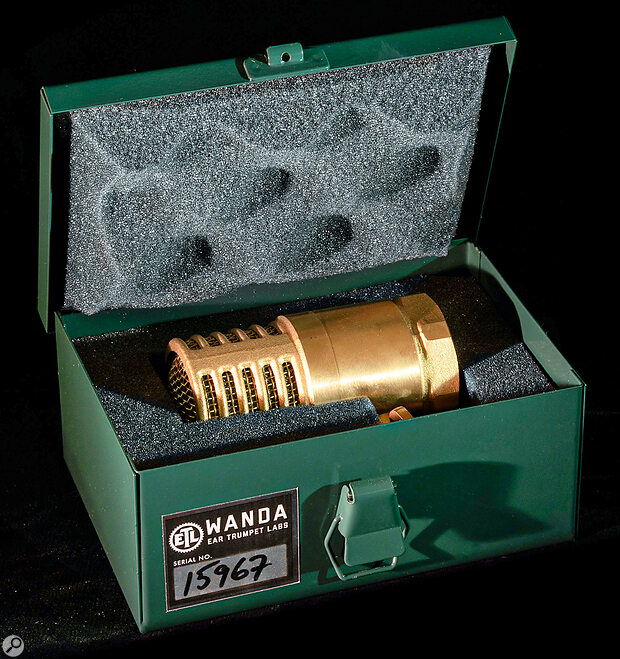Does Ear Trumpet Labs’ latest mic have a golden sound to match its opulent appearance?
 In our ever more corporate world, it’s always refreshing to discover an independent manufacturer doing things their own way. And manufacturers don’t get much more individual than Ear Trumpet Labs, who are based in Portland, Oregon. Back in the early 2000s, self‑described ‘bricoleur’ Philip Graham built some experimental mics for his vocalist daughter Malachi; word of mouth led to his being asked to make mics for other people, and the two of them now manufacture microphones as a family business in parallel with Malachi’s career as a musician.
In our ever more corporate world, it’s always refreshing to discover an independent manufacturer doing things their own way. And manufacturers don’t get much more individual than Ear Trumpet Labs, who are based in Portland, Oregon. Back in the early 2000s, self‑described ‘bricoleur’ Philip Graham built some experimental mics for his vocalist daughter Malachi; word of mouth led to his being asked to make mics for other people, and the two of them now manufacture microphones as a family business in parallel with Malachi’s career as a musician.
If you have even a passing interest in bluegrass music, the chances are you’ll have discovered Ear Trumpet Labs many years ago, because models such as the Louise, Josephine and Myrtle are omnipresent in any context where band members crowd round a single microphone and step forward to deliver their solos. That, however, is an inherently self‑limiting market, so Ear Trumpet have since diversified into studio mics, as well as models intended for close‑up use and even a dedicated large‑diaphragm capacitor mic designed to be attached to an upright bass.
What all of these models have in common apart from their naming scheme is a distinctive retro aesthetic, which I think could fairly be described as steampunk. There’s a lot of bare metal in evidence, usually sporting chunky machine screws, and the look of the aforementioned Louise, Josephine and Myrtle echoes that of the original Western Electric capacitor mics from the 1920s. Internally, however, they are all modern designs, with transformerless solid‑state circuitry that runs from conventional phantom power.
This microphone is more brassy than Tower Of Power doing brass rubbings in a brass foundry.
All That Glitters
The latest addition to Ear Trumpet Labs’ ever‑growing range is the Wanda, which is described as having “all‑brass mid‑century styling”. There’s certainly no arguing about its essential brassiness. This microphone is more brassy than Tower Of Power doing brass rubbings in a brass foundry. So brassy is it, in fact, that it looks more like a brass model of a microphone than an actual working mic. Apart from the XLR socket, every single visible component is made of raw brass, from the grille to the pivot mount to the gigantic hex nut that resembles a plumbing connector. I’m not sure to what extent this makes it ‘mid‑century’ — it doesn’t ape any specific vintage model that I’m aware of — but it’s in keeping with Ear Trumpet Labs’ house style, and instantly recognisable on any stage or screen.
The Wanda is supplied in a rather cute metal box that looks like an item of military surplus. It’s intended to be used with the integral pivot mount, so there’s no clip or shockmount supplied, just a thread adaptor for European mic stands. All that brass makes the Wanda a pretty chunky lift, weighing in at 1lb (454g) and measuring two inches across throughout. Although it’s not designed for handheld use, there’s some internal shockmounting and reasonable resistance to handling noise, so there’s nothing to stop you combining a singing session and a weights session if you want to. There’s also plenty of gauze inside the none‑more‑brassy grille, so plosive resistance is pretty good.
Ear Trumpet Labs don’t say where they source their capsules, and it’s not clear whether the transducer in the Wanda is an electret or an externally polarised design. What we are told is that it has a 26mm diaphragm and delivers a fixed, nominally cardioid polar pattern. The Wanda will work with phantom power voltages from 24 to 48 V. Being designed for close‑up use, it has a relatively low sensitivity of 3.8mV/Pa, and is designed to deliver its flattest low‑frequency response at a distance of about six inches. The output impedance is unusually low, at less than 50Ω, and self‑noise is quoted as 14dBA.
The on‑axis frequency response given in the specifications is interesting, with no broad deviations from the flat but plenty of smaller ones. There are little humps around 180 and 400 Hz, whereupon a smooth but shallow rise up to 3kHz is followed by double dips at 3.5 and 8 kHz and a peak around 10kHz. The polar plot does not show a classical cardioid shape at any of the measurement frequencies, but broadly follows the usual large‑diaphragm trend from somewhat omnidirectional at low frequencies to somewhat supercardioid at high. The Wanda’s construction is diametrically opposed to those studio mics that aim to suspend the capsule in free air, so doubtless all that brass modifies the native polar pattern of the capsule.
Magic Wanda?
Ear Trumpet Labs say that the Wanda should excel not only on live and studio vocals, but on “high‑volume applications” such as close‑miking snare drums, guitar cabs and brass instruments. Or, in other words, it’s the sort of capacitor mic designed to be used in contexts where a moving‑coil dynamic would traditionally have been first choice. And sonically, it offers an interesting contrast with most dynamic mics, and indeed with many capacitor mics designed for stage use. The upper‑midrange presence boost you find in something like a Shure SM57 or beyerdynamic M 88 is absent here. The Wanda is not a mic voiced to cut through a busy mix on a loud stage. Rather, it offers a sound that is on the smooth side of balanced: not dark or boomy, but more restrained than many other stage or studio mics.
On my own vocals, the Wanda was perfectly usable and took EQ well, but sounded a touch flat without processing. It also gave me the so far unique experience of feeling that sibilants were a little too subdued, presumably because their characteristic frequency in this case coincided with one of the dips in the Wanda’s response. The endless variability of the human voice means that all mics suit some singers better than others, and the Wanda is a better fit with voices that have a tendency to stridency or harshness. I think it would also work well on those very quiet wispy female voices you hear singing novelty ukulele‑based cover versions on insurance adverts, though alas none of them came through my studio during the review period. I didn’t manage to engage in any brass‑on‑brass action, either, but I can certainly see why Ear Trumpet Labs recommend the Wanda for trumpets and their ilk. I did try it on some other loud things, and was quite taken with the Wanda as a cabinet mic for electric guitar amps. Again, it delivers smoothness in abundance, which might not be what you want for an up‑front solo but works well to take the edge off rhythm parts that need to sit back in a mix.
 The Wanda ships in a robust and appropriately period‑styled metal case.
The Wanda ships in a robust and appropriately period‑styled metal case.
It was interesting to compare the Wanda, which uses a large‑diaphragm capsule inside a relatively closed‑off headbasket, with one of my existing favourites, the Earthworks SR117. This is another capacitor stage mic, but has a miniature capsule inside a much more open headbasket. As you’d expect, off‑axis capture was thus cleaner on the Earthworks, especially from the sides, and the cardioid pattern was noticeably better behaved. This isn’t intended as a criticism of the Wanda: it’s simply a natural consequence of the design choices that the two companies have made. The SR117 is, according to its makers, ruler‑flat across pretty much the entire frequency spectrum; in a direct comparison, it sounded crisper and more present, while the Ear Trumpet Labs mic hinted at a warmer, almost pillow‑y quality. It wasn’t a night and day difference, but enough that swapping the two mics over in most applications would have you reaching for the EQ.
You’re My Wanda Wall
Industrial design is an under‑appreciated aspect of microphone manufacture, but the look and feel of a vocal mic can be almost as important as its sound. A mic that makes the singer feel special will solicit better performances, and a mic that looks dramatic and different can turn heads right through the auditorium. The Wanda scores top marks on both qualities, and backs up its unique appearance with a distinctively mellow, laid‑back sound. It probably wouldn’t be anyone’s first choice for a death metal show, and I doubt there’s much chance of Ear Trumpet Labs releasing a high‑tech wireless version, but the Wanda is perfectly targeted at certain vocalists and genres — and is sufficiently versatile that even if it doesn’t suit a given singer, you’re sure to find a role for it somewhere on the same stage.
Summary
Standing out as much for its unmistakeable appearance as its smooth, unhyped sound, the Wanda is effective on more sources than just vocals.
